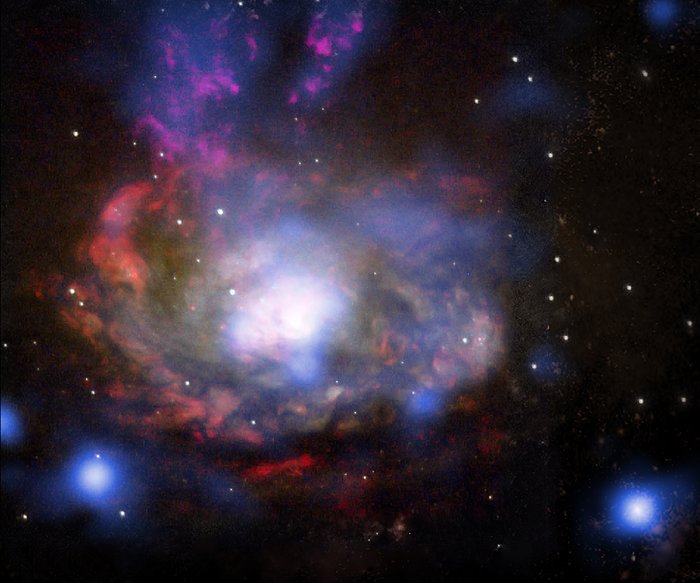SN 1996cr in Circinus galaxy
This composite image shows the central regions of the nearby Circinus galaxy, located about 12 million light years away. Data from NASA's Chandra X-ray Observatory is shown in blue and data from the NASA/ESA Hubble Space telescope is shown in yellow ("I-band"), red (hydrogen emission), cyan ("V-band") and light blue (oxygen emission). The blue source near the lower right hand corner of the image is the supernova SN 1996cr, that has finally been identified over a decade after it exploded. The supernova was first singled out in 2001 as a bright, variable object in a Chandra image, but it was not confirmed as a supernova until years later, when clues from a spectrum obtained with ESO's Very Large Telescope led the team to start the real detective work of searching through data from 18 different telescopes, both ground- and space-based, nearly all of which was in the archives. SN 1996cr is one of the nearest supernovae in the last 25 years.
Oikeudet:X-ray (NASA/CXC/Columbia/F.Bauer et al); Visible light (NASA/STScI/UMD/A.Wilson et al.)
Kuvasta
| Tunnistus: | eso0832a |
| Tyyppi: | Havainto |
| Julkaisupäivä: | 25. syyskuuta 2008 |
| Vastaavat julkaisut: | eso0832 |
| Koko: | 2400 x 1999 px |
Kohteesta
| Nimi: | Circinus Galaxy |
| Tyyppi: | Local Universe : Galaxy : Type : Spiral Local Universe : Star : Evolutionary Stage : Supernova |
| Etäisyys: | 13 miljoona valovuotta |
| Constellation: | Circinus |
| Kategoria: | Galaxies Stars |
Taustakuvat
Koordinaatit
| Position (RA): | 14 13 9.38 |
| Position (Dec): | -65° 20' 22.93" |
| Field of view: | 0.72 x 0.60 arcminutes |
| Suuntaus: | Pohjoinen on 62.2° vasen pystysuuntaan nähden |
Värit ja suotimet
| Kaista | Aallonpituus | Teleskooppi |
|---|---|---|
| Optinen OIII | 502 nm | Hubble Space Telescope ACS |
| Röntgen | Chandra X-ray Observatory | |
| Optinen V | 547 nm | Hubble Space Telescope ACS |
| Infrapuna I | 814 nm | Hubble Space Telescope ACS |
| Optinen H-alpha | Hubble Space Telescope ACS |

